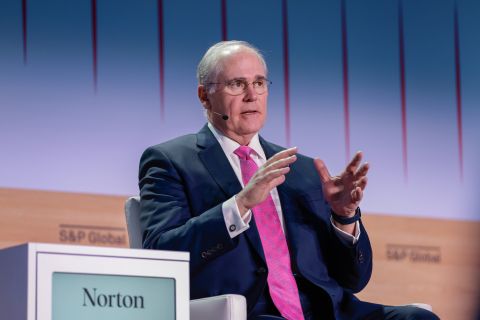 |
| Bristow is pursuing a fleet renewal and capacity expansion program that will ensure that its fleet is able to meet future oil and gas industry demands. (Image courtesy of Bristow) |
Although helicopter transport is an integral part of offshore operations, particularly in deep water, it is not one that normally gets a lot of attention. The reason, in part, is that it is not the highest dollar item on the list when it comes to project costs.
Helicopter logistics are a crucial component of many offshore activities, however, and reliable service is vital. And while drilling rigs can be refurbished and boats can be overhauled, helicopters that are in service have to be replaced every 20 to 30 years, depending on the market and the aircraft. Today, the majority of the current fleet is approaching the end of its service life. These retiring aircraft will create a shortage, and manufacturer capacity may not be able to keep up with demand over the long term.
Meeting logistics needs
According to Meera Sikka, vice president of global business development at Bristow Group, the company’s core business is oil and gas. Bristow is actively pursuing a fleet renewal and capacity expansion program that will ensure that its consolidated fleet operating in more than 20 countries is able to meet future industry demands.
Bristow is already three years into an upgrade program and plans to largely complete it over the next several years. “There is a great push from oil and gas companies for new types of aircraft,” Sikka said. “They see the safety enhancements and operational improvements. They know the financial advantages of fewer flights with greater payloads.”
It appears that Bristow’s timing could not have been better. Just as it began its upgrade program, new helicopter designs were entering the market.
“There haven’t been many new designs to speak of in the last 20 years. In the last five years, however, manufacturers have produced new designs, primarily to meet new oil and gas industry demands,” Sikka said. “Customers have come to us and said, ‘We’re going to go 200 nautical miles offshore. Can you do it?’ Our smaller aircraft cannot go the distance, but the new medium and large helicopters we are adding to the fleet will be able to meet customers’ expectations.”
Gearing up to go the distance resulted in a recent sale of some of the company’s domestic assets, with 53 of the small single-engine helicopters that served the US Gulf of Mexico (GoM) being sold in October 2008. The objective of this sale was to redeploy capital into newer, larger high-technology aircraft capable of operating further offshore and in harsh environments, explained Mark Duncan, senior vice president western hemisphere. The sale was a strategic move to follow production into deeper water.
Of course, investing in higher capacity assets will also generate higher returns for the company. “The fact is that we can get the same revenue from two to three large helicopters that we were able to get from the 53 aircraft sold — and we can do it more efficiently,” Duncan said. “In the shallow water of the GoM, older helicopters can operate efficiently. In many other markets, on the other hand, our customers are requiring the newer technology helicopters.” Since about two-thirds of Bristow’s revenue comes from overseas, the sale of the GoM assets makes sense.
At about the same time that Bristow sold the 53 GoM aircraft, the company increased its ownership of Norway’s Norsk Helikopter AS to 100%. The reason for this purchase, Duncan explained, was to gain a larger share in a growing market.
Training
While the company is expanding its fleet, it is also investing in people. Pilots and mechanics are in great demand and short supply. Bristow Academy is the vehicle through which the company is addressing this need.
According to Patrick Corr, Bristow senior vice president global safety, training and standards, Bristow is one of several large helicopter operators in the world. “Of all of the companies that have 50 or more helicopters,” he said, “we are the only one with our own training academy.”
The Bristow Academy has three campuses in the US and a campus in Gloucester, England, that was acquired in December 2008. The new facility offers instrument training and multi-engine training for European bound trainees, a certification offering no American schools can provide. “We are the only school that offers American FAA qualifications as well as European JAA training,” Corr said.
The size of the academy is another of its selling points. “Size enables us to operate certain economies of scale for training equipment and facilities,” Corr said, noting that the curriculum includes specialty programs such as a training taught exclusively in Spanish with about a dozen Spanish speaking instructors.
Training internally provides another advantage — a source of consistent pilot supply. “If we’re going to spend US $20 million on a helicopter, we have to have six pilots to keep it flying,” Corr explained. Training internally gives the company a degree of certainty that critical personnel resources will be available.
As is necessary in other segments of the industry, there is also the matter of employee retention. Mentoring is part of the plan. “We mix experienced and inexperienced pilots for mentoring purposes from the very first posting,” Corr said, “and we make a practice to promote from within.”
Another element of the retention program is that it provides a career path that Corr says includes “excitement and opportunity that spans the world.” Young people entering the training programs have different expectations than their predecessors. “Many have no qualms about leaving a job if they aren’t satisfied. They want to have significant change every five to six years. If we can do that by stationing them in different places fulfilling different roles, they are more likely to stay and become future leaders of our organization.”
Challenges ahead
While the company is addressing the issues of assets and personnel resources, there are challenges that go beyond the logistics business itself.
Bill Chiles, president and CEO, believes that one of the biggest challenges today is a result of the run-up in crude prices and the subsequent sharp decline. “Service costs in other segments were pushed unreasonably high,” he said, “and the fall in oil prices is going to require oil and gas companies to get costs in hand. With the current commodity price models we’re looking at, the industry is going to have to get more efficient and reduce operating expenses.”
While other service and supply companies increased rates threefold as oil and gas prices soared, Bristow’s rates went up 30-50%, Chiles said. “We will get pressure to reduce our pricing, but we have far less margin to cut than other service segments of the industry.”
If the present financial situation has the impact predicted by analysts, every facet of the industry will be affected. A large cash reserve will be critical to operate through the energy cycle.
Bristow prepared for this eventuality prior to the economic downturn by building up a cash reserve to pursue its growth objectives. “We’re pursuing $1 billion of those growth opportunities at present,” Chiles said, noting that one constraint for every company moving forward will be the ability to raise additional capital as needed. Chiles believes the challenge presented by dynamic market changes is one Bristow is prepared for. “We have a significant growth plan that includes a goal of increasing revenues to $1.5 billion by fiscal year 2011, and we’re well on our way to achieving that goal,” he said.
Recommended Reading
Crescent Energy to Buy Eagle Ford’s SilverBow for $2.1 Billion
2024-05-16 - Crescent Energy’s acquisition of SilverBow Resources will create the second largest Eagle Ford Shale E&P with production of about 250,000 boe/d, the companies said.
Diamondback’s Van’t Hof Plays Coy on Potential Delaware Divestiture
2024-05-16 - Diamondback Energy’s President and CFO Kaes Van't Hof also addressed new Permian exploration and the lack of “fun” dealing with the FTC on its deal to buy Endeavor Energy Resources.
Minerals Market Growing But Needs More Scale, Consolidation
2024-05-15 - The market value of public minerals and royalties companies has doubled since 2019—but the sector needs to grow even larger to attract generalist investors into the fray, experts say.
ONEOK CEO: ‘Huge Competitive Advantage’ to Upping Permian NGL Capacity
2024-03-27 - ONEOK is getting deeper into refined products and adding new crude pipelines through an $18.8 billion acquisition of Magellan Midstream. But the Tulsa company aims to capitalize on NGL output growth with expansion projects in the Permian and Rockies.
TotalEnergies, Sinopec to Develop SAF Unit in China
2024-03-26 - TotalEnergies and Sinopec’s production unit will have the capacity to produce 230,000 tons of sustainable aviation fuel per year.





